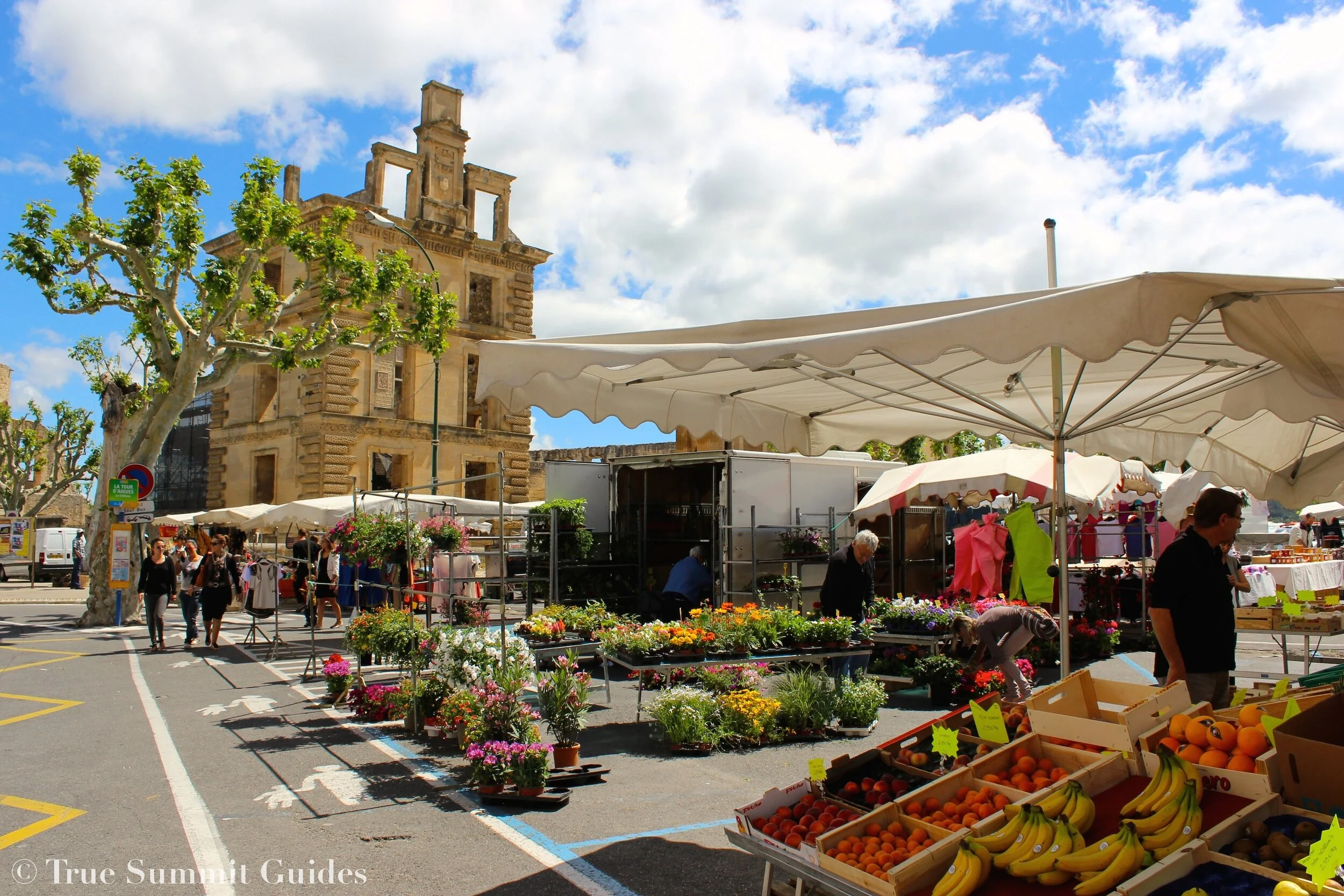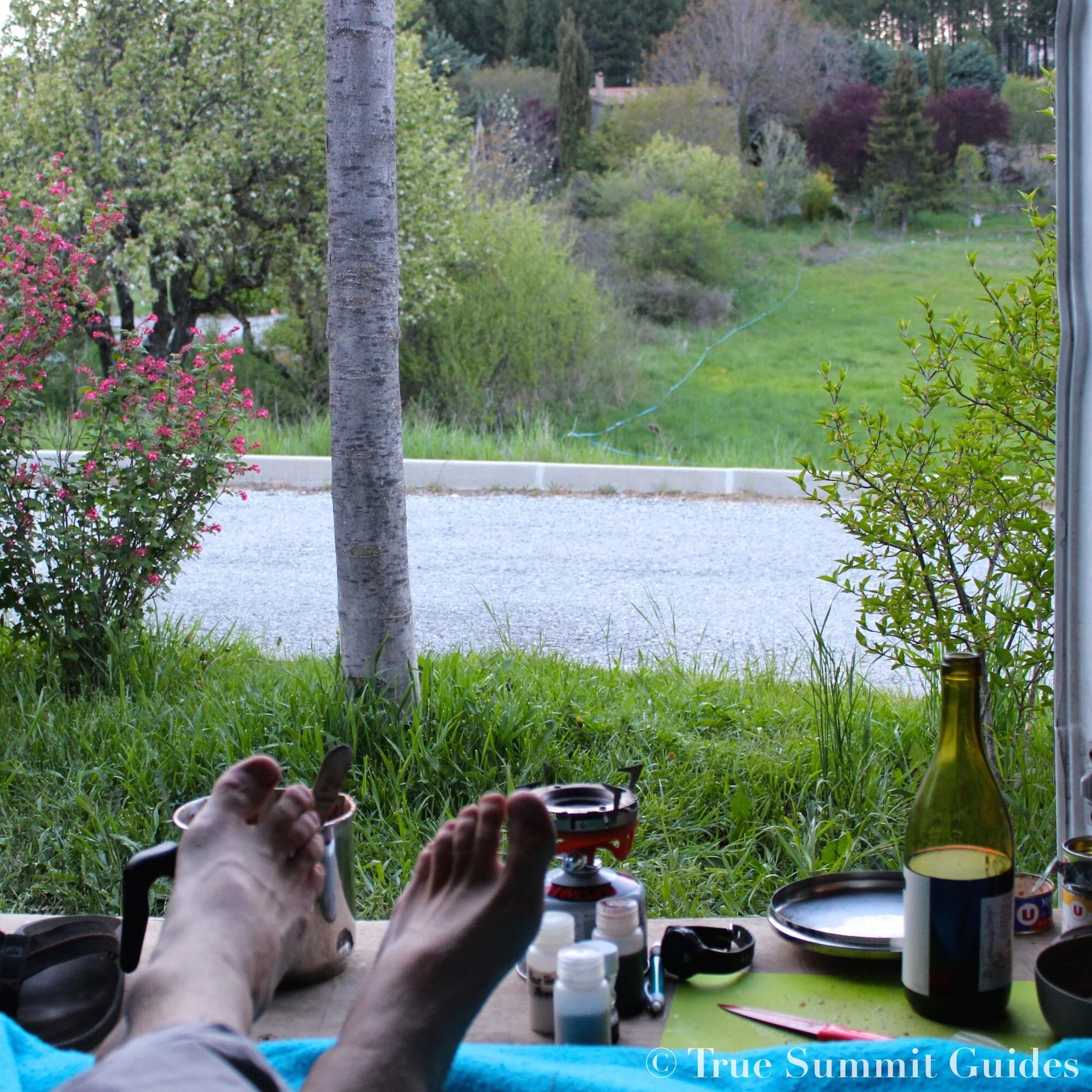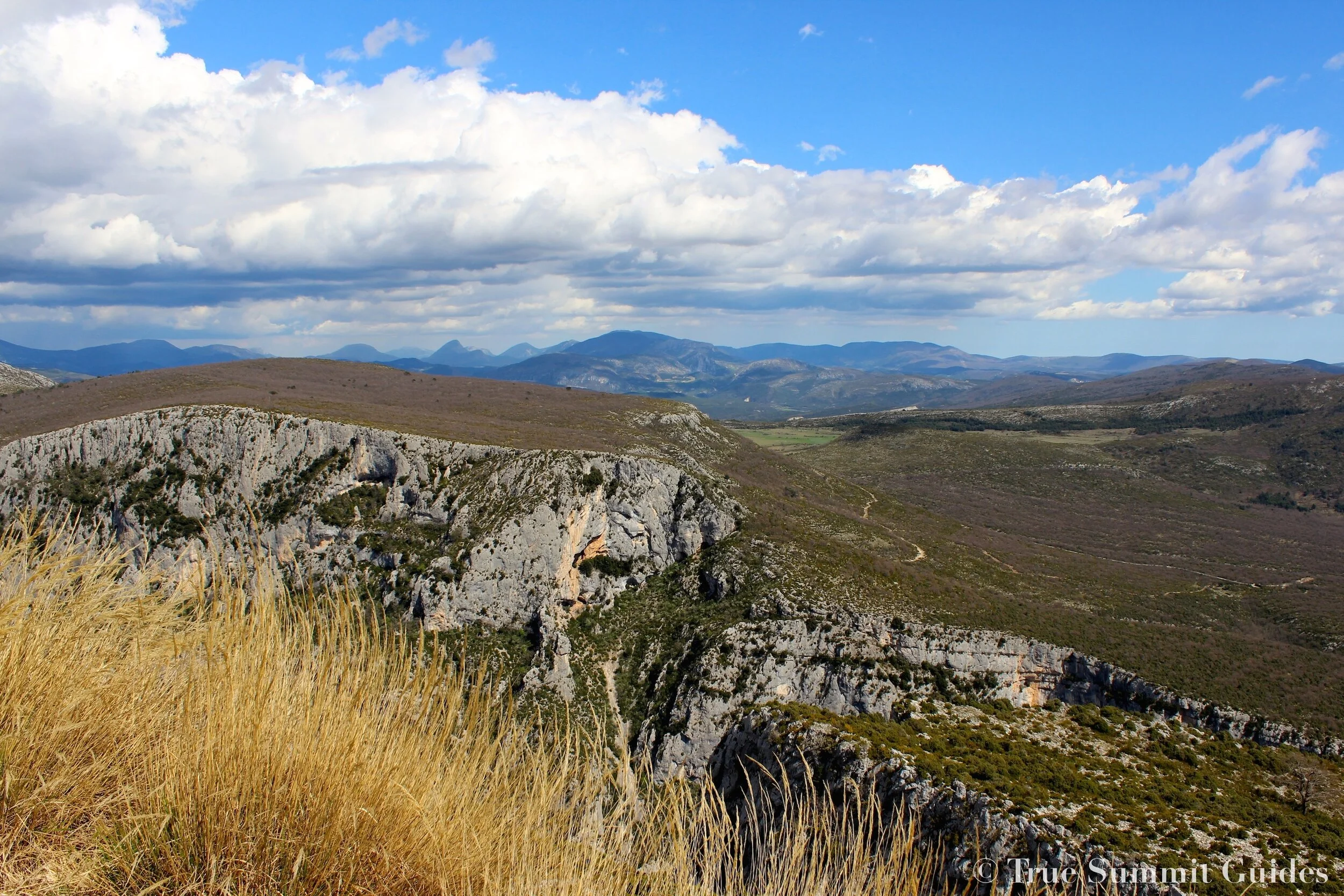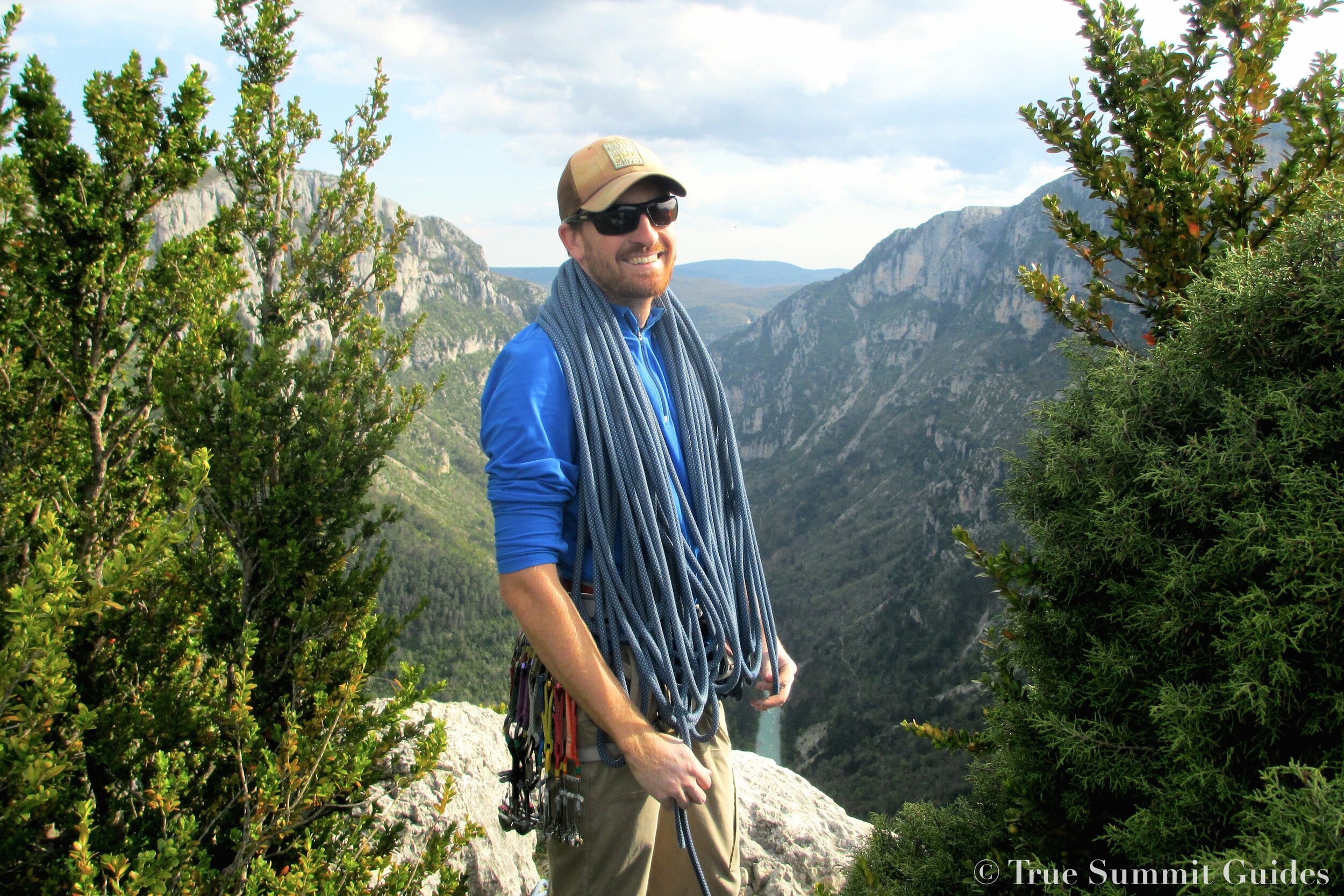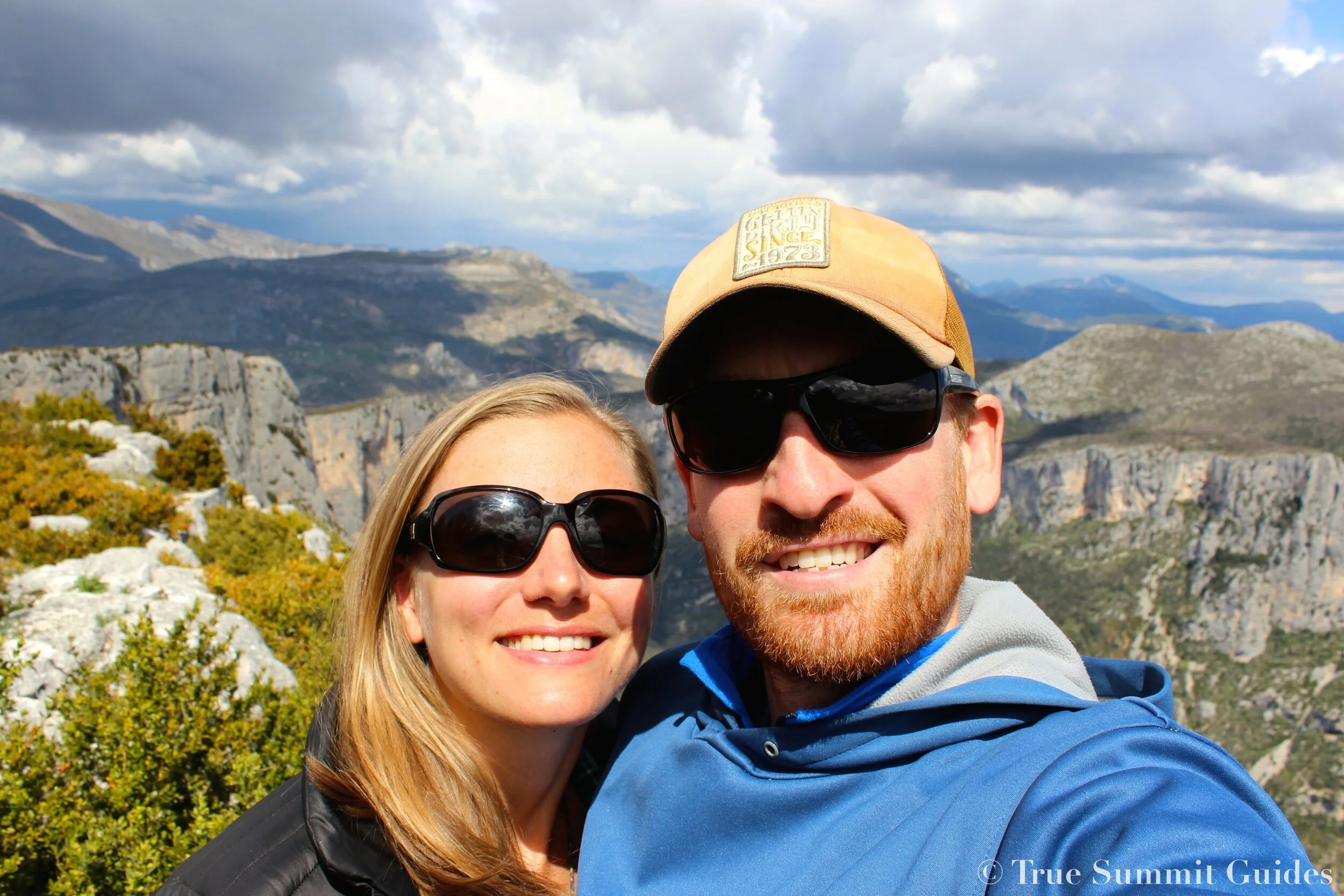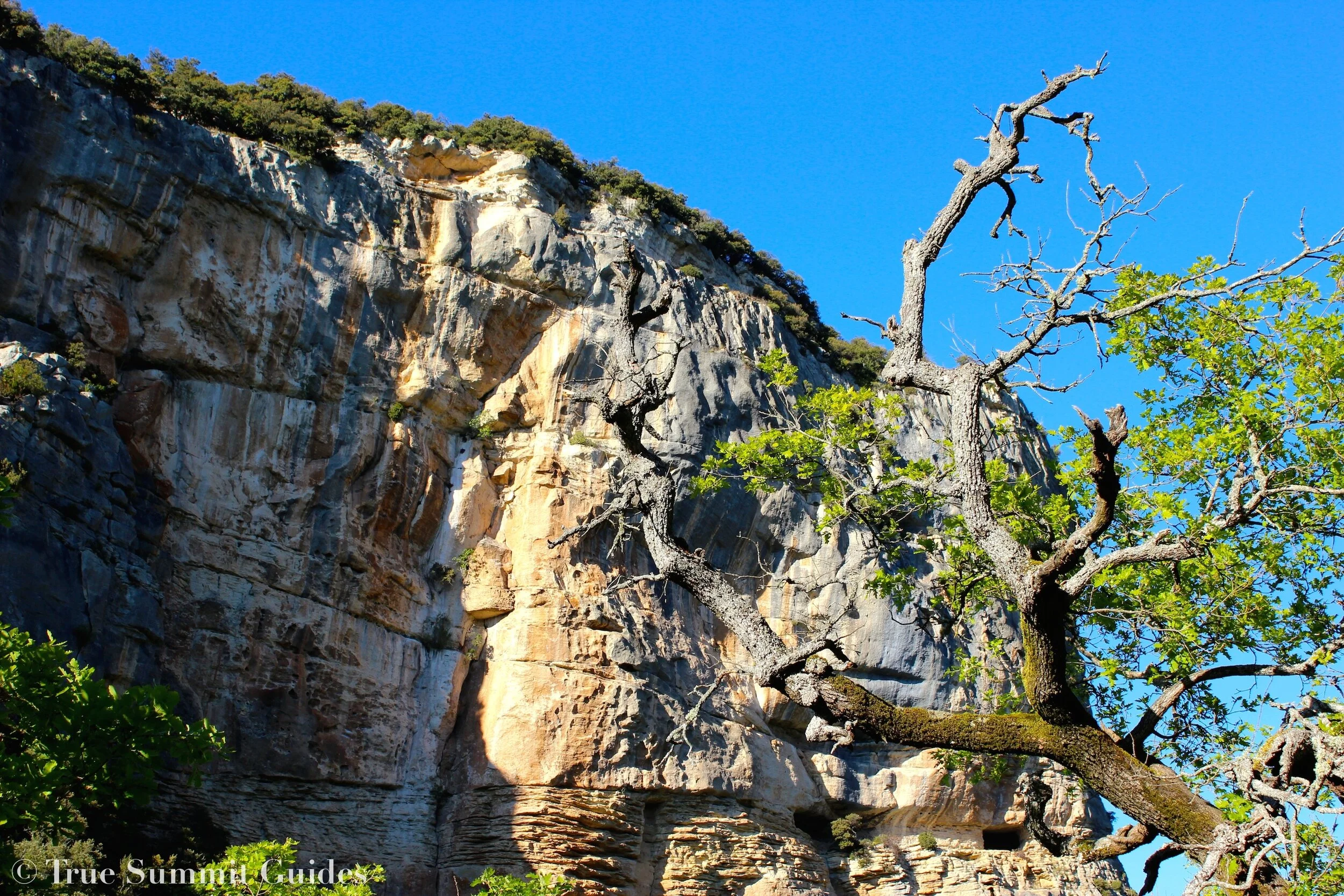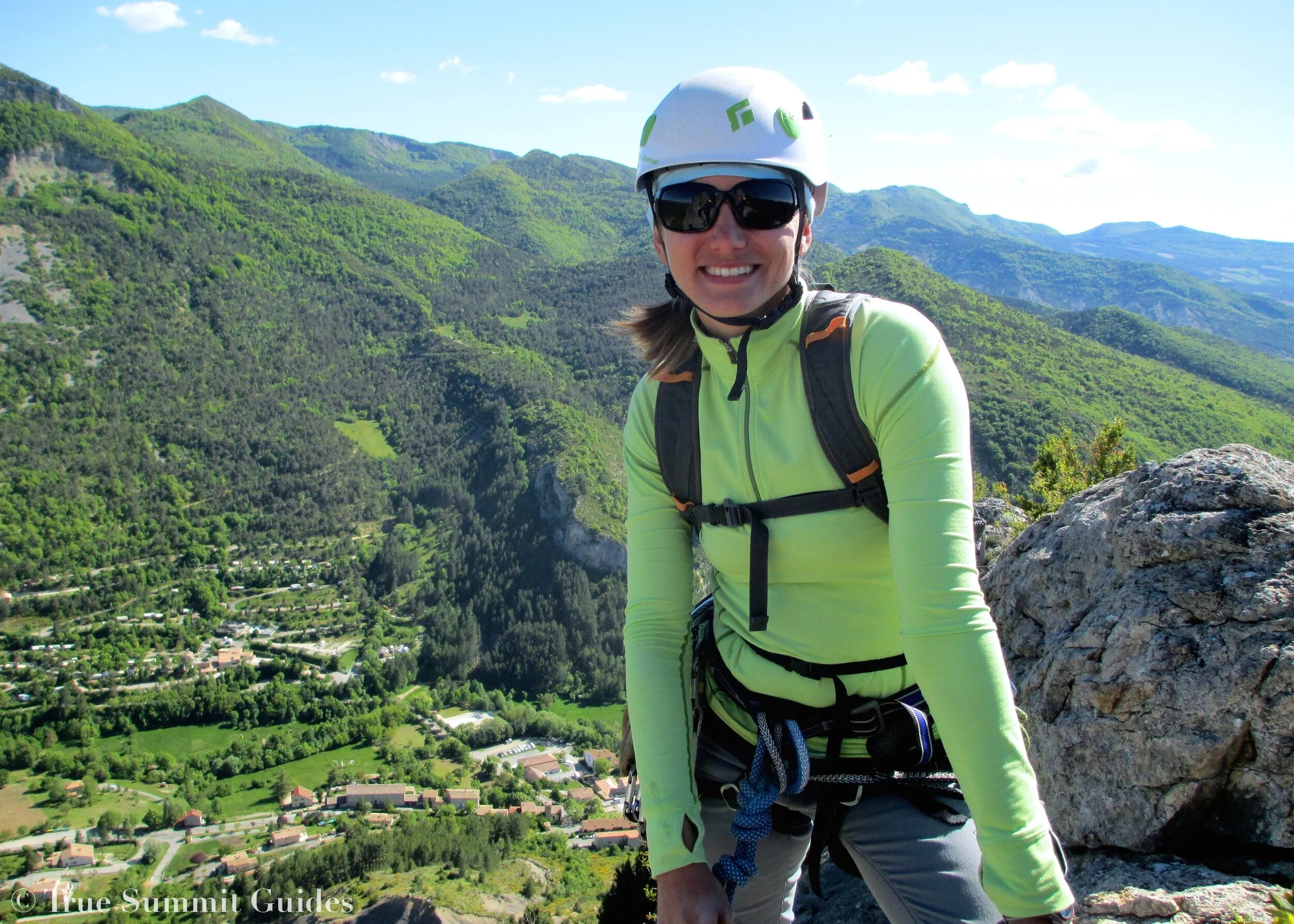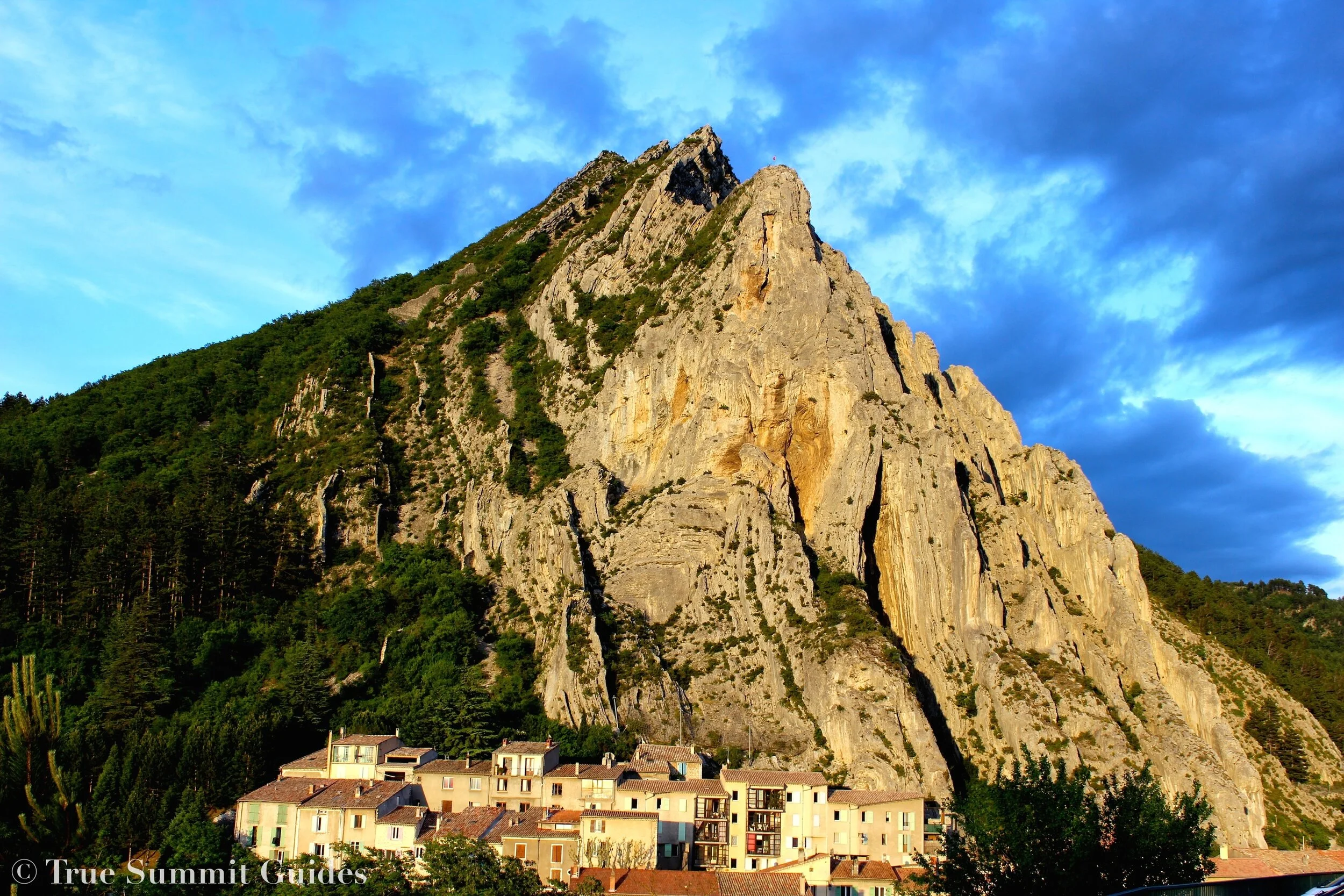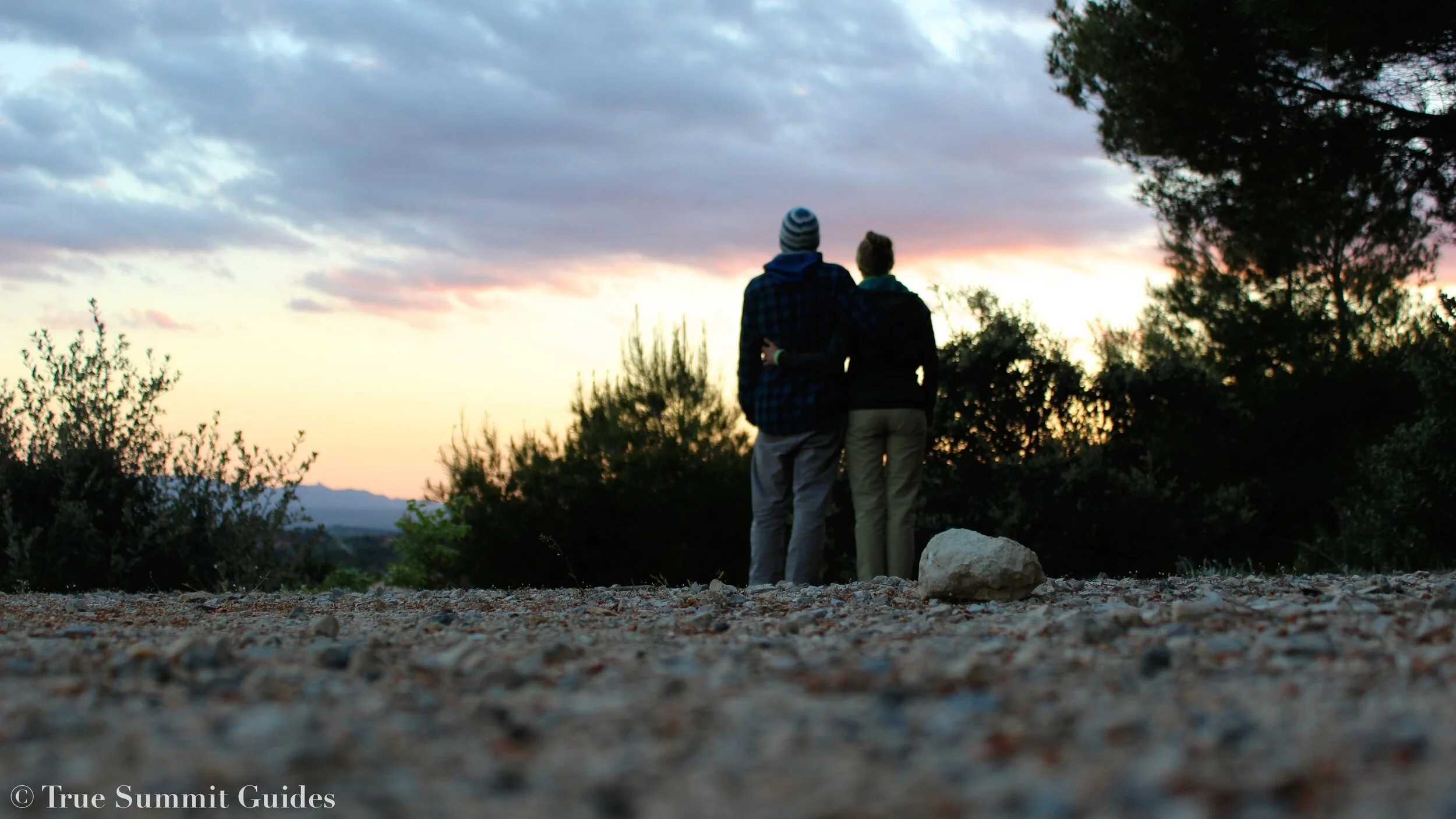French Dispatch #3: Springtime Among the Lubéron
Words by Dave Shuey. Photos by Noémi and Dave Shuey.
After an amazing month of climbing in Spain, we packed our four heavy bags and boarded a train for the countless vineyards, expansive countryside and warm climate in the south of France. Although it was difficult to leave behind the rock faces and culture of Catalonia, one can easily be drawn into the comfort and tranquility of Provence. Not to mention, we were certainly looking forward to home cooked meals, a comfortable bed and hot showers every day. And with several world-renowned climbing sites just a short distance away, we settled into our new home in La Tour d’Aigues quite happily.
Noémi’s sister, Dorothée, and her family were gracious enough to have us in their home for the following few months. The comforts of such a big family home were definitely welcome after a month of living out of a car and tent in the cold of winter, and we arrived ready for some well earned relaxation time. However, the timing of our arrival from Spain worked out perfectly in that we were able to tag along for the family’s annual winter ski trip in Queyras, which we certainly couldn’t refuse. So with one day to wash our beyond-smelly clothes and catch up on a bit of sleep, we quickly set out for a busy week of skiing.
A small town in the southern French Alps, Queyras features plentiful slopes for skiing in winter as well as hiking and climbing in summer. This was Noémi’s first time skiing and although I have snowboarded for years, I was very excited to expand my skills on skis. We spent all seven days of the trip out on the slopes and by the end of the week we were feeling really comfortable. (Noémi still likes the “pizza” position a little too much.) By the end of the trip, we were able to take several ski lifts up to the very top of the mountain, with wonderful views of the surrounding range, and take some of the more challenging routes all the way to the base of the resort. Luckily there had been a good amount of snowfall the few days before we arrived, so the snow was great quality, and afterwards we had plenty of sunshine to keep us warm for long days on the slopes. Tired, sunburned and content, we headed back to the south of France for the rest and relaxation awaiting us.
Nestled into a warm, dry pocket of southern France, the small farming village of La Tour d’Aigues dwells amongst the rolling foothills of the Lubéron mountain. With a climate similar to Paso Robles, California, this region of Provence is covered with acres of vineyards and farmland as far as the eye can see. The Centre Ville is dominated by the ruins of an ancient castle, with an elementary school next door, an outdoor market every Tuesday and several small cafés and specialty shops on the surrounding narrow streets. For those in pursuit of an active lifestyle, the rolling terrain and moderate springtime conditions of the area provide the perfect training ground. With eyes and ears alert for the frequent tractors bumping along nearby, one can find ideal paths for cycling and running on these quiet, winding country roads. And just a short distance away on the Lubéron range, miles of dirt trails climb the relatively mild slopes of the 3,000 foot ridge, great for hiking and mountain biking. Needless to say, this outdoor playground would offer us the perfect region to prepare for our mountainous pursuits of the upcoming summer.
This area also provides amazing opportunities for rock climbing. Although perhaps more commonly known as a summertime escape for Northern Europeans to bask in the sun, enjoying pâte and rosé by the warm waters of the Mediterranean, the regions of Provence-Alpes-Cote d’Azur and Haute-Alpes also provide plenty of quality limestone for ambitious climbers. The shining white cliffs of the Calanques in Marseille, the picturesque and towering south face of the Sainte-Victoire, the power-endurance routes in Buoux, the old-school routes lining the canyon walls along the Gorges du Verdon, the vertical fortress of Sisteron, the great cathedral of rock in Orpierre, and the world-renowned overhangs of Céüse offer outstanding climbing without the commitment factor of the greater Alps massifs. Thanks to our springtime base camp, we had unique access to this tremendous quantity of rock and were able to take one to two week long excursions to several venues just 30 to 90 minutes away.
In addition to developing our strength as climbers, this spring we started thinking about our upcoming objectives in Chamonix and began training for long distance trekking routes and alpine adventures. Using Training for the New Alpinism by Steve House and Scott Johnston as a guide, we began a training program that would get us in shape for the impressive mountains of the Alps. When we weren’t climbing, we spent our time going for long walks and jogs around the surrounding vineyards, sprinting up the hill that led to the house, and even using the backyard play set for pull-ups and circuit training. We were able to see a lot of the local countryside this way, and took advantage of the wonderful springtime weather and fresh air of Provence. After the cold months of winter, it was wonderful to soak up the sunshine and warmth in La Tour d’Aigues and its neighboring villages. I could not imagine a more ideal place to do this training. Although we originally envisioned a strict adherence to the program, we quickly found that weeklong climbing trips made it difficult to maintain hours of hiking and hill-sprints each week. We instead found long hikes to do on our climbing trips and focused on the program while we were resting at home. We have since decided against alpine objectives in Chamonix, mainly because of our lack of gear and the funds to produce said gear. However, we are planning two long distance backpacking trips, and the endurance training we have been working on will certainly pay off soon.
Our introduction to Provençal rock climbing began with a local crag just 20 minutes away from home. With a couple weeks of rest under our belts after our busy ski trip, the small roadside cliff near the quaint town of Mirabeau served as an excellent warm up crag for a quick return to fitness. Great for local beginners to hone their skills, the routes at Pont Mirabeau offer a fun collection of easy climbing on decent limestone. The views of the old bridge towers on each bank of the Durance River instill a feeling of historic presence while you clip your way up 15-25 meter lines of polished rock. Within a few afternoons we had pretty well ticked off the routes available and had received a rejuvenated strength to tackle larger objectives.
After eyeing its impressive ridgeline several times from the nearby highway, we chose the dominating presence of the Sainte-Victoire Mountain for our first main climbing objective. From the north side of the mountain, one sees a gently sloped hill with green meadows and bright wildflowers, inspiring hikers of all abilities to tighten up their boots for a spectacular day’s hike. The south face of the very same mountain, however, paints a much different picture. Here you will not find the same gentle paths of its rolling nordwand. From the base of this face, a towering wall of limestone rock will require rock shoes and careful footwork for those wishing to ascend its exposed lines. There was good reason for the artist Paul Cézanne’s desire to capture the majestic and bold ridgelines of this famed Provençal monolith. Beneath the imposing south face, in a campground named after the very same painter, we established our home for a full week with nothing but climbing and hiking on our agenda.
After having spent a day cragging the base of the monolith a couple weeks earlier, we knew that there would be plenty of quality routes to keep us busy throughout a weeklong stay. With the weather forecast looking solid for the days to come, we hopped on a bus for the short ride from the campground to the climbing area. The various sectors at the base of the wall offer a pleasing mix of classic and modern routes with typically well placed bolts. Sometimes the hardware on the classic routes can be rather spaced apart and a bit on the rusted side, requiring a constant “do not fall” mentality of the leader’s psyche. And for those fearful of climbing ropeless, a stick clip would be extremely helpful, as the first bolt of each route is often only found after several moments of searching 15-20 feet off the deck. However, once the first bolt is reached, the routes in this area are generally well bolted and lead to quality anchors. Within a short stroll along the crag’s base, dozens of single and multi-pitch routes can be found, ranging from easy slabs with blocks and jugs galore, to super steep lines requiring dicing footwork on little nubbins. We spent most of our time in the central sectors like the Aiguille Bertine and Plates Dalles, ascending their mid-5.10 slabs and verticals. Parcours Sentez (5.10a), Bisou N’Ours(5.10a) and Que la Fête Commence (5.10b) proved to be a few of the more memorable lines for us. With easy access to the large population living in southern France, these immensely popular crags feature a lion’s share of glossy polished lines where herds of locals slip and slide their way up and down the routes. Although a major downfall of popular climbing areas, the polish and traffic can typically be escaped by upping the difficulty towards the 5.10-11 options nearby.
We had intended to have a go on the ultra-classic Grand Parcours, but between 17 pitches of climbing and a walk-off descent almost equally long, we felt that with our limited time the commitment was a bit too much to take on. The route follows a stunning line, face climbing the slab up the triangular Aiguille Bertine, followed by a scramble up a sweeping ridgeline, and concluding with a final four pitches of crack jams and stemming up a beautiful corner system below the summit. The steep lower slabs and upper cracks give the route a 5.10- rating, with the majority being a 5.7 scramble. The real crux of the route would seemingly come from the commitment of ascending 17 pitches and descending the walk-off in time to catch the last bus back to camp. Although too much for our first trip to this mountain, it has definitely been added to my to-do list for its admirable approach of the technical ridgeline ascent to the summit.
However, this is not to say that we would not make sure to reach the summit by different means. From our campground on the southeast side of the mountain, within the small town of Puyloubier, a hiking trail ascends countless switchbacks towards the Sainte-Victoire’s east-west ridge. From here the trail joins the well established Grand Randonnée trail continuing along the ridgeline towards the western summit. Although a moderately challenging 13.5 mile roundtrip with 3,600 feet of vertical gain, this is a hike that should definitely not be missed! With views north towards the fertile, rolling Provençal hills, and south towards Côte d’Azur and the Mediterranean Sea, the trail crosses alpine meadows that deliver a powerful aroma of wildflowers and prominent rocky spires with chossy ascents. Once the true summit is reached, with your heart pumping and your thighs burning, the real turn around point is finally seen and appears distant still. Although the views from the summit are spectacular, your gaze is drawn towards the Croix de Provence at the far end of the ridge before the mountain sharply drops off at its sheer west face. Originally built in the 18th century and with numerous restoration efforts since, the cross stands 19 meters high and can be seen from miles in any direction.
With a well earned summit view after an outstanding ridgeline trek and some twenty pitches of climbing under our belts, the Montagne Sainte-Victoire proved to be everything we had hoped it would be. In addition to a quality adventure in its own right, the level of fitness gained with a week spent climbing, hiking and eating well enabled us to feel confident about our next excursion. I first discovered the Gorges du Verdon about a year ago when watching a short film by Keith Ladzinski featuring climbers Nina Caprez and Jonathan Siegrist. These stunning cliffs would definitely be a must visit location during our spring in the south of France.
Rising up above the famously bright turquoise-green river, walls of rock curtain the gorge up to 700 meters high, while griffon vultures soar amongst the cliffs. Often called the “Grand Canyon of Europe,” the Gorges du Verdon induce a dizzying vertigo as you peer off into the abyss. The atmosphere and exposure provided by this one-of-a-kind geographic wonder draw tourists and climbers alike to experience its majestic qualities firsthand. With roads winding about the rim of each side of the canyon, the accessibility to such a unique place flocks copious visitors each year. During the summer vacation season, the gorge experiences a Yosemite-like traffic volume and we were thus fortunate to visit in the far mellower spring season. Although if you climb anywhere near a look-out point, even in spring you still have to allow for crowds of tourists taking photos and videos of you while you climb. Weather permitting, we had a full week to take advantage of the climbing available without too much interference from other climbers.
Unlike our low-budget rental car situation in Spain, getting a car for a week’s use in France proved to be far more expensive. Luckily our small town provided a solution in the most unlikely of places. Turns out that supermarkets here not only sell shoes, televisions and jewelry, they also have cheap rental cars! Armed with a big Fiat utility van from our friendly, neighborhood Super-U, we headed northeast through a torrential downpour to the gorge about 90 minutes away. After researching trains, busses and campsites, and the hassle associated in traveling to a place nestled more in nature than in metropolis convenience, it was quickly decided that renting a van would serve us well in both transportation and sleeping arrangements. For barely over the price of public transportation and campground fees, we had both a dry place to sleep and convenient travel with our Super-U Fiat. After weeks of sleeping in a car during our February excursions, our first introduction to van life would prove to be a most splendid one. The van was larger than we had intended, but the wood lined interior (think U-Haul moving truck) allowed us height to stand and plenty of room for our air mattress and climbing gear. The convenience of van life instantly appealed to us during the rainy approach, as we would normally be forced to pitch our little tent upon arrival, in the downpour, all while attempting to keep our gear dry. Nestling our van into a parking lot in the small town of La Palud, we fired up the stove for dinner and happily listened to the rain pelting the outside of our dry sanctuary.
Although the weather continued to stay ominous the following day, we were able to make our first approach to the cliff’s edge to view what was in store for us over the next week. Initially, the thought of first descending by rappel off the rim and into the vast abyss before climbing back out again made my skin crawl with nervousness. What if we rappel in and the climb is too difficult to make it back out? Typically you walk to a wall, begin climbing and if something goes wrong, there is usually the option of bailing off an anchor to the safety of the ground below. With a unique style of climbing and rappelling in reverse order, the gorge upped its ante with an additional level of mystic and intrigue. Bailing here was seemingly out of question. Nevertheless, I was armed with a guidebook and a climbing ability to match our chosen routes.
Gorges du Verdon is a mecca of historical influence within the climbing culture. Although the major classics were originally climbed via the traditional ground-up style, the accessibility of the rim above the cliffs offered themselves effortlessly to the modern style of top-down rappel bolting. In the 1980s, Verdon Gorge was one of the first areas to establish routes with this top-down approach, enabling bold climbing along the sheer faces of the cliff that were previously considered inaccessible. Some of the lesser repeated routes have seen a decay in their hardware over the last 30 years, but the popular routes have mostly been refitted with newer expansion or glue-in bolts to provide a comforting level of safety as you clip your way back to the rim.
For an initial taste of the rock without getting too far over our heads, we headed out to dabble at the single-pitch routes available beside the overlook at the Papy on Sight sector. It was still a strange and eery feeling to rappel down that first time, but once I reached the small ledge when a pair of old bolts anchored the belay, I took a look back up and the feeling of a normal climb became apparent. Once I was standing below the route instead of above it, everything fell into place and I felt instantly at ease. We climbed up and rappelled back down a half dozen 5.10 pitches, including A Moi les Vivantes (5.10a) and Tarsinge l’Homme Zan (5.10a), with a truly unique atmosphere that I had never experienced before. We were climbing only single-pitch routes, yet below our belay ledge the cliff steepened back in to an overhang and left an exposed 1,000 feet of air below as we climbed. The feeling was out of this world!
From the dry comfort of the van, we waited out the rainy weather that befell on us every other day. We may have escaped the tourist trap of summer, but the spring climate in the foothills of the Southern Alps proved to be as inconsistent as one might expect. One of our rest days from climbing, when the weather was less than clear, we were able to explore the river below with a hike along its banks. From the Couloir Samson parking, just below the Point Sublime lookout, we took a historic trail leading through the darkness of the old and lengthy mining tunnels beneath the northern cliff. This genuinely unique walk, with spectacular views of the gorge from below, should not be missed if venturing to Verdon. But don’t forget your headlamp! We admired cliff caves that once offered safe haven to the ancient original residents of the gorge, and now provide habitat for swallows and vultures. After ascending the steel staircases built as an improvement to the mining ladders of old, we decided to turn back as the weather turned grim. The route covers the length of the northern river bank and is a truly stunning portion of one of the numerous Grand Randonnée hiking routes established throughout France.
As our week was drawing to a close, we still had one major classic that sought our attention. We had our minds set on the classic six pitch route ascending the top half of the Dalles Grises wall. As the next day was a Saturday and the sector a popular one, we decided to park our van on the rim of the cliff in front of the short approach trail to ensure we could be the first ones down the rappel route in the morning. We woke and made a quick breakfast to a cool but blue bird clear sky and made our way to the rappels. As we began to descend, our convenient sleeping placement proved a success as two additional parties began to gather behind us at the rim. Three full double rope rappels later, two of which we shared with a kind IFMGA guide named Geoff, we found ourselves on a spacious mid-cliff ledge called the Jardin des Écureuils, or Garden of Squirrels. The sector’s namesake route travels up massive broken slabs and flakes for 150 meters. The route is graded 5.10a, generously bolted to require none of the cams I brought along, and save for a couple tricky moves, felt a good deal easier than its grade. All the same, the 3 hours spent climbing Dalles Grises were the best we had experienced during the week. We even met up with The North Face team athletes Matt Segal and Emily Harrington mid way up the route as they were rappelling towards the base of the wall. After a short chat at our belay, I led the final pitches with a joyous jump in my step knowing we were sharing the wall with today’s modern elite.
After a mellow afternoon, sipping percolator espressos while overlooking the cliff as the clouds danced above, we made our way back to town with a feeling of great contentment. Nothing beats the natural feeling you breathe in as the post-climbing stoke warms your heart. Over a cheap bottle of wine and van made pasta dinner, we aimed to keep that feeling alive for as long possible on our last evening at the Gorges du Verdon before returning to our Lubéron base camp.
Just a 40 minute mountainous drive from La Tour d’Aigues, we were also able to make a couple day trips to peruse the popular sport climbing ground of Buoux. During the 90s, this hot bed for young talent attracted elite climbers from all over the world to have attempts at the cliffs overhanging, power routes. As climbers of a more moderate ability, we still found the rock to be of top quality and a pleasant place to spend some time getting strong. Tucked above a creek in a thicket of forest, the cliff band wraps around and features various slabs, cracks, dihedrals and arrêts for climbers of all abilities. The sector La Dérive contains fun featured lines with a couple of favorites being the classic crack corner La Gibottière (5.10a) and the friction testing arrêt La Dérive des Incontinents(5.10c). It was also great trading off burns with a party of locals attempting a slippery, barely featured 5.12a route, only have each of us peel off the wall on the same tricky sequence.
Another day at Buoux, we headed off to check out the steep slabs of Mur Zappa. Unfortunately a number of the routes have seen their share of traffic and feature a good deal of polish, but nonetheless they proved their worth. The slabs have just enough bits of holds to give you something to smear on, but certainly not enough to inspire loads of confidence while your toes inch up a few feet past your last bolt. Yet pushing through those butterflies is all a part of the game, and your efforts are often quickly rewarded with a subsequent send. Bas les Masques (5.11a) and Kadjet Tropic(5.10c) were two of these routes and the feeling that builds as you surpass their respective cruxes and clip the chains is simply indescribable! After a couple visits to Buoux, we felt our strength and confidence continue to rise and knew we were ready to take on our final climbing road trip of the season.
After about an hour’s drive from our local crag at Mirabeau, we ventured into the Haute-Alpes region, full of limestone cliffs just begging to be climbed. With three destinations in mind over the course of the next two weeks, we opted for another dose of Super-U van life. As we traveled north, the quaint village of Sisteron straddles the Durance River with its massive rock tower flanking one side and an old, stone military fortress rising above the other. We eagerly gazed out the windows of the van to the vertical lines of rock across the water, knowing that we would wait until our return trip south before stopping to explore them. Instead, we continued northwest towards the lesser known, yet perhaps more enticing village of Orpierre. This miniature town is socked in between rolling fields of apple trees to the east, limestone cliff bands to the north and west and the truly impressive Quiquion rock to the northeast. We knew little of this area, but our guidebook showed plentiful single-pitch sport routes and a number of 5.9-10 mutli-pitches up the south face of the tower. As we pulled the van into a parking lot and took a moment to look around, we knew we had chosen an excellent spot to spend the better part of a week.
Parked amongst a few other camper vans with the convenience of nearby public toilets and drinking water, we were perfectly situated to take advantage of the positive weather forecast for the next week. The following morning, with the standard dose of oatmeal, granola and fruit in our bellies, we made the easy fifteen minute approach up to a fairly vertical wall called Belleric. Joined by a group of teenagers on a youth climbing day trip, we were certainly not secluded, yet enjoyed a good day on some challenging routes. The wall features some lengthy pump-inducing lines with quality, bouldery sections mixed throughout. One such route, Ça Roule Ma Poule (5.10b), involves a good 45 meters of moderate, straight-forward moves until a roof segment. The roof was not overly intimidating, with decent holds for hands within sight, yet the foot holds beneath were less than convincing. Reaching up, I grabbed a sloping hold with my left hand, readjusted my feet, and quickly found the pump in my forearms growing beyond comfort. Shifting weight towards my right hand, moving both feet above the lip of the roof, I spotted a decent ledge just below the next bolt. With my endurance running on empty I had to attempt a dyno left-handed towards the ledge. To my surprise, my hand caught the edge and stuck it, yet moments later as I began to shift feet my finger power blew out and I peeled from the wall with a thrilling whipper, finding myself a good 15 feet below the roof. Three more times I inched my way up to my highpoint only to take a screamer each subsequent time. Pumped to the limit, I lowered off defeated. Noémi faired far better making quick work with two 5.10a onsight ascents of Les Bijoux de Spaggiari and La Voie de Son Maître, on a steep section in the middle of the wall.
While single-pitch routes are great to push the limit and test your skills, it is on those long multi-pitch ascents that our smiles truly reach ear to ear, and Orpierre offered plenty. Quiquion extends from the main circle of cliffs on its lower northern side, but its true grandeur lays where the rock sweeps up with its towering summit looming over the small village below. The striking prow visually dominates the cliff, with cracks, slabs and overhangs comprising its faces. With a short approach and scramble around the prow we headed off towards its southeast face where the majority of Quiquion’s single and multi-pitch climbs are located. Our first line of choice was the 5.10- slab climb (turned wandering parcours) known as La Grotte. A tremendous first pitch follows a slab directly up with plenty of pockets, flakes and edges to keep the movement varied and unique along the limestone line. The first few pitches offered fairly direct climbing before veering off right to bypass a much steeper 50 meter bulge. One exposed pitch traversed among blocks and flakes above a large cave, leaving me mostly hanging from an anchor directly above the apex of its arc while I belayed in Noémi from the left. A couple more direct pitches led to the summit with magnificent 360-degree views of the fertile yet mountainous land all around. A tremendous two-step, double-rope rappel, one that we would get to repeat twice more in the next few days, placed us safely back on the stable ground below. La Grotte offers unique movement throughout its six pitches and should definitely be on the list of a visiting climber!
With high praise from fellow visitors, the next day we headed up a route called Brasil. Although slightly easier than the previous route, we were up for some vertical milage and the recommendation made it all the more convincing. The climb was, however, mostly monotonous, pulling up huge jugs and flakes with bolt protection ridiculously close together. With the first three pitches within reach of a single rope, I was able to take advantage of the easy terrain by clipping about one of every three bolts, and after 70 meters of rope drag and scrambling, I completed the link-up with just enough gear left to manage a suitable anchor. Halfway up the route, we found that a few routes criss-crossed paths and decided to veer left on the steeper and more enticing section of La Jungle en Folie. The name of the route is given for the initial bushy “jungle” section, yet by switching to the route halfway up, we bypassed the bush-whacking and enjoyed the sublime upper crux pitches of pumping and technical movement over various bulges. Nailing the 5.10c pitch onsight quickly made up for the much less spicy first half, and after another scrambling pitch we stood on the summit again with smiles on full display.
Our last day in Orpierre brought us back to the cliff’s stunning prow and its classic route climbing the large lower dihedral, aptly named Le Dièdre Sud. The sun was shining and the weather beautiful as Noémi and I swung leads up this impressive line. It is a popular climb and we practiced our speed as a party of two Frenchmen followed us pitch for pitch. After breathing in the gorgeous views of the summit one last time, we took the long rappel down feeling very satisfied with our trip thus far. This classic climb marked an excellent end to our time in this unique destination, and we celebrated in our usual fashion with pizza and beers in the town below. Although not quite as internationally known as our next destination, Orpierre should definitely be on all visiting climbers’ itinerary. That said, after a good night’s sleep in the van, we packed up and headed towards the location already on everyone’s agenda, the truly epic cliff band of Céüse.
Easily one of the most famous, if not the most renowned sport climbing cliffs in the world, Céüse attracts climbers from all stretches of the globe to have a go on its steep, technical lines. The cliff is perhaps most famous for its inclusion of the first ever climb graded 5.15. Chris Sharma first ascended the extension to Biographie, calling the line Realization, and with that effort put Céüse on the map for all the climbing community to drool over. To really take advantage of the routes available, as numerous as they are, a visiting climber must be ready to pull really, really hard. With only a handful of routes in the lower 5.10s, an ability to ascend 5.12 is seemingly mandatory. Without that much power in the tank, nonetheless, we had about four days to sample some of the easier lines and simply enjoy our time among the elite climbers at the cliff. However, our timing was less than ideal and as we pulled in to the parking lot at the base of the hill, the rain began to pour.
Anyone who has taken a climbing trip for any length of time will concur that patience truly is a virtue. For an outdoor sport as dependent on weather conditions as climbing is, waiting out the poor weather means hours (if not days) stuck in a tent or van. Luckily we were stocked fresh with books, movies and cards. I have found that reading short stories by Jon Krakauer such as “Eiger Dreams”, “Club Denali” and “The Devil’s Thumb” are a sure way to stay stoked and keep the passion high during miserable weather windows. This, combined with Noémi’s apparently never-ending winning streak in cribbage, kept us busy enough as we waited out the storm. After a couple days trapped in the van, we awoke one morning to clear and sunny skies. After waiting a couple hours for the rock to dry, we made our way up the famously steep hour-long approach towards the top of the hillside. Once above timberline, the grassy meadows break away to the stunning exposed cliff band elegantly marked with vertical streaks of black and orange along its outwardly arcing face. Climbers were scattered across the cliff making attempts on impossibly difficult lines as we traversed the base towards the busiest section. Because it contains nearly all the 5.10 routes of the entire cliff, the sector Demi Lune will never cease to bring in a crowd. And so we mingled with like-minded climbers from all over the world, enjoying the clear weather window and feeding off of each other’s motivation and encouragement on this challenging crag.
With the weather as inconsistent as it was, we were only afforded two days to take a small taste of the lines available. The uniqueness of the climbing at Céüse lies within its sustained difficulty for the entire length of a route. It was a most humbling experience hopping on a 5.10- route only to get spit off a quarter of the way up with forearms pumped like Popeye’s, yet without the spinach induced power, feeling more like his little lady Olive. With some routes, a whooping holler of a redpoint success was bellowed, yet most went the way of a hang dog disgrace with all effort expended in simply reaching the chains. Because of this sustained difficulty, I believe that the true secret to climbing at Céüse is found in minimally gripping the small crimps and maximizing rests from the larger pockets. Success at this crag requires a good deal of time to adjust yourself to the difficult grades and the necessary technique, which was not really possible within our short time frame. However, we were able to enjoy some excellent routes in the Demi Lune sector such as Les Sucettes à l’Anis, Katina, Carte Noire and Un Panda sur la Banquise (all 5.10b), regardless of the style in which the top was reached. With only a few days left of our two week adventure, we took another rainy day as a clue that it was time to leave Céüse and make our way back south towards Sisteron and the spectacular rock we had only glimpsed on our way up.
Split in half by the Durance River that runs north to south, the small yet busy town of Sisteron attracts tourists and climbers alike for its impressive architecture and rock formations. The formidable stone fortress looms over the city above the west bank, while the vertically striped Rocher de la Baume rises up from the east side of the river. The rock reminds me of Devil’s Postpile in the Sierras with its formation of long, thin sheets of dark grey stone emerging from below to meet high above with the formation of a central spire. Stepping inside one of the large vertical openings, a vault-like cavern provides shelter from the heat and sunshine, with a steep slab featuring tiny holds on the left and an impressive overhanging wall to the right. After the cold and rain of the previous week, we instead gravitated toward the sun and warmth on the much brighter south face. From the turn of the cave to where the exposed rock meets the hillside, Rocher de la Baume’s large south face provides four sections of climbing with plenty of routes of all difficulty.
The heavily featured walls with cracks, flakes, arrêts and dihedrals came as a welcome relief from the pumpy, sustained pockets and crimps of a couple days prior. I found myself enjoying the movement of careful footwork inching up a slab, to carefully jammed fingers in a half-inch crack, to laybacking a corner system all within a single route. After the humbling experience of Céüse, the confidence of scaling difficult routes more in tune to my style was incredibly encouraging, as seen with each line’s onsight success. The route Deux Trois Quarts(5.10b) climbed a central spire of cracks and flakes, Les Doigts de Fée (5.10b) followed a left-arcing line along a powerful arrêt and Le Dièdre (5.10a) offered a classic corner system on a pillar with views down the length of the river. Although often hot in the direct sunlight, the clear weather allowed for a much needed full day of climbing and lounging about the rocks.
With our two week road trip coming to a close, we took our trusty Super-U van back to La Tour d’Aigues for some desperately needed showers and home cooked meals. Although Céüse is certainly the best known of these three destinations, it was the climbing and village of Orpierre that stood out to me as the most memorable. The rainy weather and small amount of time available were not enough to properly enjoy Céüse, and I hope to make a return trip in a couple years for a longer period of time and with more advanced sport climbing skills under my belt. Blessed with a full week of sunshine in Orpierre, the long multi-pitch ascents and challenging single-pitch routes offered us amazing sights and adventures that will not soon be forgotten.
Aside from climbing local cliffs and jogging around vineyards, our springtime base camp in La Tour d’Aigues allowed us three months to enjoy the comforts of living in a real home. We cooked large meals for the family, swam in the pool, read many books, enjoyed high-speed wifi, played games with the kids and lounged in the Provençal sun. It is easy to take simple pleasures like these for granted in daily life. But after several months of travel and outdoor living, you come to truly appreciate basic amenities like heat, plumbing and furniture, as well as the energy and warmth of living with a large family. We are incredibly grateful to our hosts for having us for such a long period of time. It was wonderful for Noémi to spend so much more time than she ordinarily could with her distant family, and for me to finally meet everyone after hearing so much about them.
We started this European adventure as the leaves fell in Fontainebleau, we felt the cold of winter in Paris and Spain and have now seen the changes of spring pass through southern France. In the surrounding fields, the vineyards became green and bushy, the flowers bloomed and fell and the fruit trees flourished before picking. Aside from the occasional Mistral wind that torments this region, for the most part we experienced the mild and pleasant weather that we expected. We took great comfort in the sunshine, not just for its warmth and restorative properties, but because it reminded us of our gentle climate back home in San Diego. However, seasons change, and so does our itinerary. We will now trade out our home for a tent and travel to the most fickle and unpredictable weather system of our trip, the French Alps, for a summer of climbing, hiking and waiting out the rain in Chamonix.

